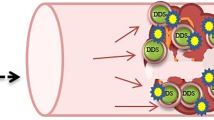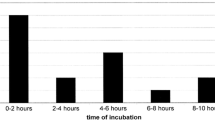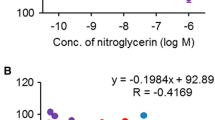Summary
The thrombolytic and hemodynamic properties of intracoronary streptokinase (SK) application were studied in anin-vivo canine model with left circumflex coronary artery thrombosis, initiated by electrical stimulation (150 μA, DC for 6 h) of the artery's intima via an implanted silver wire. In pentobarbitalanesthetized, open-chest dogs acute myocardial ischemia was determined by a dehydrogenase-dependent staining of the coronary artery perfusion area. Thrombus weight was determinedpost-mortem.
Saline-treated control animals developed coronary thrombosis after 3.1±0.4 h of stimulation. Thrombus weight was 64±3.1 mg. Acute infarct volume was 32±3.1% of total left ventricle, and 53±6.2% of the coronary artery risk region for infarction. At occlusive thrombosis, blood pressure, ventricular pressure and the LV dP/dtmax fell significantly, whereas heart rate and the end-diastolic filling pressure increased. Severe ST-segment elevation and loss of R wave voltage indicated myocardial ischemia. At 20 min into thrombotic vessel occlusion, 2,000 IU/min SK were infused by way of a Sonescatheter advanced to the thrombus. Coronary thrombosis consistently lysed after 12±0.7 min of SK infusion, and coronary blood flow as well as hemodynamics were restored. Only minor acute infarction was found indicating viability of ischemic jcopardized myocardium. In another group, the continuous SK-infusion (20 IU/kg/min) concomitant with electrical vessel stimulation prevented coronary thrombosis and acute ischemia, and no significant hemodynamic alterations were noted.
These results indicate that intracoronary SK-infusion can lyse acute thrombosis as sequel of electrical stimulation. This prevents development of acute myocardial infarction. Continuous SK-infusion can completely prevent coronary thrombosis in response to intimal injury.
Similar content being viewed by others
References
Rentrop P, Blanke H, Karsch KR, Kaiser H, Köstering H, Leitz K (1981) Selective intracoronary thrombolysis in acute myocardial infarction and unstable angina pectoris. Circulation 63:307–317
Baroldi G, Radice F, Schmidt G, Leone A (1974) Morphology of acute myocardial infarction in relation to coronary thrombosis. Am Heart J 87:65–75
Chandler AB, Chapman I, Erhardt RL, Roberts WC, Schwartz CJ, Sinapius D, Spain DM, Sherry S, Ness PM, Simon TL (1974); Coronary thrombolysis in myocardial infarction. Am J Cardiol 34:823–833
Hofmann M, Hofmann M, Genth K, Schaper W (1980) The influence of reperfusion on infarct size after experimental coronary artery occlusion. Basic Res Cardiol 75:572–582
Smith GT, Soeter JR, Haston HH, McNamara JJ (1974) Coronary reperfusion in primates. Serial electrocardiographic and histologic assessment. J Clin Invest 54:1420–1427
Salazar AE (1961) Experimental myocardial infarction. Induction of coronary thrombosis in the intact closed chest dog. Circ Res 9:1351–1356
Kordenat RK, Kezdi P, Stanley EL (1972) A new catheter technique for producing experimental coronary thrombosis and selective coronary visualization. Am Heart J 83:360–364
DeWood MA, Spores, J, Notske R, Mouser LT, Burroughs R, Golden MS, Lang HT (1980) Prevalence of total coronary occlusion during early hours of transmural myocardial infarction. N Engl J Med 303:897–902
Romson JL, Haack DW, Lucchesi BR (1980) Electrical induction of coronary artery thrombosis in the ambulatory canine: a model forin vivo evaluation of anti-thrombotic agents. Thromb. Res 17:841–853
Romson JL, Bush LR, Haack DW, Lucchesi BR (1980) The beneficial effects of oral ibuprofen on coronary artery thrombosis and myocardial ischemia in the conscious dog. J Pharmacol Exp Ther 215:271–278
Sandritter W, Jestädt R (1958) Triphenyltetrazoliumchlorid (TTC) als Reduktionsindikator zur makroskopischen Diagnose des frischen Herzinfarktes. Verh dtsch Ges Pathol 41:165–171
Karsch KP, Rentrop P, Hofmann M, Blanke H, Schaper W (1981) A new experimental model for induction and lysis of coronary thrombi. In: Myocardial Revascularization. Eds Mason DT, Collins JJ, p 461–463, Yorke Medical Books
Ganz W, Buchbinder N, Marcus H, Mondkar A, Maddahi J, Charuzi Y, O'Connor L, Shell W, Fishbein MC, Kass R, Miyamoto A, Swan HJC (1981) Intracoronary thrombolysis in evolving myocardial infarction. Am Heart J 101:4–13
Chandler AB, Chapman I, Erhardt LR, Roberts WC, Schwartz CJ, Sinapius D, Spain DM, Sherry S, Nees PM, Simon TL (1974) Coronary thrombolysis in myocardial infarction. Report of a workshop on the role of coronary thrombosis in the pathogenesis of acute myocardial infarction. Am J Cardiol 34:823–833
Davis MJ, Woolf N, Robertson WB (1976) Pathology of acute myocardial infarction with particular relevance to occlusive coronary thrombi. Br Heart J 38:659–665
Reimer KA, Lowe JE, Rasmussen MM, Jennings RB (1977) The wavefront phenomenon of ischemic cell death. 1. Myocardial infarct size vs duration of coronary occlusion in dogs. Circulation 56:786–794
Baugham KL, Maroko PR, Vatner SF (1981) Effects of coronary artery reperfusion on myocardial infarct size and survival in conscious dogs. Circulation 63:317–323
Murdock DK, Loeb JM, Euler DE, Randall WC (1980) Electrophysiology of coronary reperfusion. A mechanism for reperfusion arrhythmias. Circulation 61:175–182
Lang TW, Corday E, Gold H, Meerbaum S, Rubins S, Costantini C, Hirose S, Osher J, Rosen V (1974) Consequences of reperfusion after coronary occlusion. Effects on hemodynamic and regional myocardial metabolic function. Am J Cardiol 33:69–81
Rutsch W, Schartl M, Mathey D, Kuck K, Merx W, Dörr R, Rentrop P, Blanke H (1981) Percutaneous transluminal coronary revascularization: Procedure, results, and acute complications. Am Heart J 102:1178–1181
Pierce SA, Kinard SA, Diethrich EB, Koopot R (1982) Outpatient cardiac catheterization and coronary arteriography: Safe and cost-effective-Report of 1000 cases. Am J Cardiol (abstract) 49:939
Giddens J, Lee G, Krieg P, Kozina J, Dajee A, Yin E, Grehl T, DeMaria AN, Mason DT (1981) Reversal of acute coronary thrombotic occlusion and myocardial injury utilizing streptokinase. Clin Res (abstract) 29:8A
Romson JL, Haack DW, Abrams GD, Lucchesi BR (1981) Prevention of occlusive coronary artery thrombosis by prostacyclin infusion in the dog. Circulation 64:906–914
Kaspar RL, Barnes GE, Peterson DF, Bishop VS (1975) Specificity of autonomic influences on cardiac responses during myocardial ischemia. J Appl Physiol 38:485–490
Marshall RJ, Parratt JP (1980) The early consequences of myocardial ischaemia and their modification. J Physiol (Paris) 76:699–715
Moore S, Belbeck LW, Evans G, Pineau S (1981) Effects of complete or partial occlusion of a coronary artery. Lab Invest 44:151–157
Kjekshus JK, Maroko PR, Sobel BE (1972) Distribution of myocardial injury and its relation to epicardial ST-segment changes after coronary artery occlusion in the dog. Cardiovasc Res 6:490–499
Ribeiro LGT, Hillis LD, Maroko PR (1981) Evolution of epicardial R wave voltage following experimental coronary artery occlusion: effects of hyaluronidase. Cardiovasc Res 15:425–429
Chesterman CN, Cederholm-Williams SA, Allington MJ, Sharp AA (1977) The formation of a fibrinogen-activator complex by the action of streptokinase. Thromb Res 10:421–430
Simon TL, Ware JH, Stengle JM (1973) Clinical trial of thrombolytic agents in myocardial infarction. Ann Int Med 79:712–719
Author information
Authors and Affiliations
Additional information
Professor Dr. Otto Bayer in memoriam
Rights and permissions
About this article
Cite this article
Fiedler, V.B. Thrombolytic effects of intracoronary streptokinase on canine coronary artery thrombosis. Basic Res Cardiol 79, 17–26 (1984). https://doi.org/10.1007/BF01935803
Received:
Issue Date:
DOI: https://doi.org/10.1007/BF01935803




